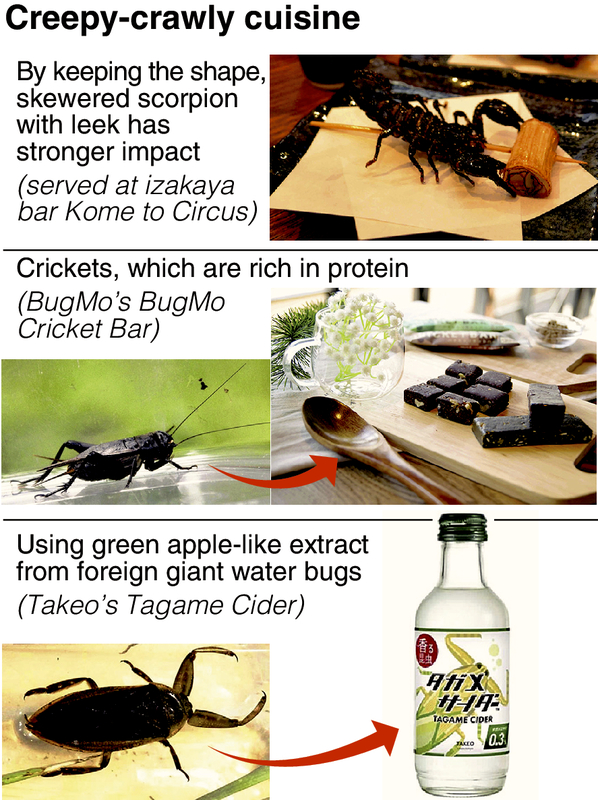
Crickets, scorpions and giant water bugs. They seem to have nothing in common, but they are all in fact prime candidates as foodstuffs. In an effort to alleviate food shortages accompanying world population growth, a United Nations body is also encouraging insect consumption, which has been booming, particularly among young people.
Raised in a special environment
"The taste differs depending on the species. You may need guts to try the first bite, but it's surprisingly good," said Wataru Murase, 24, a collage senior from Shibuya Ward, Tokyo.
Murase was eating six assorted insects and grilled skewered scorpions with leek at an izakaya bar called "Kome (rice) to Circus" in the Takadanobaba district in Tokyo. At the same table, his friend Yuki Oura, 22, also a college senior, was eating an insect and smiling while pointing a smartphone camera at the dish, saying, "It's instagrammable."
Among other insect dishes, the menu features skewered cicadas with their larvae, and cricket udon noodles. A skewer of deep-fried scorpion --although not an insect -- was 1,480 yen. I turned my eyes from the menu toward the surrounding tables and saw there were insects everywhere.
The insects are not randomly caught outside but farmed and fed in a clean environment. Distribution volumes are therefore limited, and purchase prices are high. Even so, this restaurant enjoys an increasing number of orders, which have grown 1.5 times over the past three years to 500 a month. Manager Kakeru Ishii, 29, said insects are now the restaurant's most popular items on the menu.
Easy to grow
Edible insects have recently been frequently featured on TV and YouTube. The boom is believed to have been triggered when the U.N. Food and Agriculture Organization (FAO) reported in 2013 that insects are a valuable food source.
According to the U.N., the world's population is 7.7 billion, with one in nine people suffering from chronic food shortages. The population is expected to increase -- mainly in China, India and Africa -- to more than 10 billion in the 2050s. The FAO focused on insects as the "saviors" of the upcoming population explosion and food shortages.
The FAO report states that insects are easier to grow than livestock, such as cattle and pigs. Producing 1 kilogram of beef requires 8 kilograms of fodder, while it takes only 2 kilograms to grow insects. Insects are also highly nutritious. Some insects contain 1.5 times more isoleucine -- a muscle-building amino acid -- than beef.
Nagoya Women's University Prof. Naomi Katayama, a nutrition specialist, said: "Edible insects have boomed among young people who are not familiar with traditional Japanese insect consumption. Considering food issues, it's important to acknowledge that insects can be eaten."
Product is diversifying
Stores specializing in edible insect-based food are increasing, diversifying the diet.
BugMo Inc. in Kamigyo Ward, Kyoto, sells protein bars each containing nutritious substances extracted from 25 crickets. Selling 1,000 a month, the high-protein bars are available in such places as gyms and offices. The market for edible insects in Japan is said to be worth several hundred million yen. Expecting the market will grow several dozen-fold in 10 years, the company cultivates crickets at its own farm.
Takeo LLC in Taito Ward, Tokyo, sells snacks made from hot-dried tarantula and crickets. The company originally sold them exclusively online when it launched in 2014, but finally opened a brick-and-mortar store last year.
"Every time you eat them, you discover something new, and that's what's great about edible insects," said manager Michiko Miura.
This reporter tried Batta-moku Mix, a mix of grasshoppers and crickets. It looks just like cricket or grasshopper mummies, but when I put it in my mouth... the crunchy texture was actually good. It did not have a fishy smell, but rather an elegant tea-like fragrance which spread in my mouth.
On an autumn night when a beautiful sound reaches my ears, I cannot help but wonder what the speakers of those sounds taste like.
Traditional food in mountainous area
In Japan, insects have long been a foodstuff for ordinary people. There is a record that entomologist Tsunekata Miyake conducted a nationwide survey in 1919 to find that 55 kinds of insects were eaten in 41 prefectures.
Even today, locusts and bee larvae are simmered and eaten mainly in mountainous areas. In Nagano Prefecture's Ina region, types of insects inhabiting rivers such as dobsonflies and caddisflies are known as zazamushi, and boiled down in soy sauce to be served as tsukudani dishes as a valuable source of protein. In the upper reaches of the Tenryugawa river in the prefecture, zazamushi fishing is a winter tradition.
In foreign countries, insects are eaten mainly in Southeast Asia. According to the FAO, 1,900 kinds of insects are eaten around the world, of which beetles account for 30 percent.
Read more from The Japan News at https://japannews.yomiuri.co.jp/







